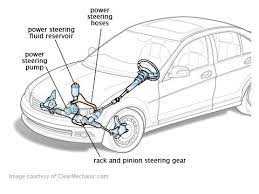Steering Wheel Hard To Turn: Causes, Solution


The steering system is a key component of a vehicle’s control mechanism. It allows the driver to direct the car in the direction he or she chooses.
A steering wheel that is difficult to turn is dangerous because it might cause an accident when driving on a highway or a street that is congested with automobiles or people.
Consider the following scenario: you need to change lanes or make a turn, but your steering wheel sticks or goes slowly. If you are traveling on a dangerous, mountainous road, this may be a fatal situation.
What Are the Causes of Steering Wheel Difficulty?


The stiff steering wheel is caused by irregular maintenance and late servicing, as well as wear and tear on specific components. It is critical to be aware of them since they will enable you to detect warning signs early and take your vehicle to a mechanic before they worsen.
- Tire Inflation
Surprisingly, low air pressure can make the steering wheel difficult to turn. Improper tire pressure, particularly deflated tires, might cause this issue. All of your vehicle’s tires should have been inflated to the manufacturer’s suggested PSI.
READ MORE: Symptoms of a bad crankshaft position sensor
Also, the front-end alignment is another important thing. Uneven wear on the front tires will make your car pull to a side while driving or taking a turn.
Uneven tire tread leads to misalignment of the wheels, which can also be the reason that triggers hard and stiff steering at the time of making turns on the road.
- Damaged Steering Rack
A series of shafts and U-joints connect the steering rack to the wheel. Simply driving causes these pieces and the rack itself to get damaged and worn.
If you notice the stiffened wheel right after starting the car, the fault is almost certainly with the steering rack. When you continue driving, the wheel will progressively feel free to move. It happens because the rack heats up while the engine runs, allowing the oil to settle in.
You can continue driving in this condition, but leaving the degraded rack in place will exacerbate the problem.


- Bad Serpentine Belt
A cracked or broken serpentine belt is another common reason for the steering wheel’s difficulty turning. Because it is always in use as you drive the automobile, the belt wears out over time.
When the belt begins to deteriorate and become loose, the wheel begins to show signs of stiffness. Delaying maintenance or replacement will cause the belt to snap, rendering the steering wheel useless.
- Leakage of Fluid
Another major cause is an insufficient level of fluid in the steering system. It occurs when the pressurized hose area leaks or becomes loose. Fluid escapes through the break, lowering system pressure and drying out the pump.
As a result, the wheel does not receive an adequate amount of fluid to operate freely.
- 5. Pump Failure
Along with the fluid, the pump is critical in maintaining the proper amount of pressure in the power steering system. It would be difficult to crank the steering wheel if the pump is damaged or stops working for any reason.
A faulty pump will not entirely stop the wheel. You can still move it, but it will require much more work, which could be dangerous if you need to make a quick bend on the road.
6. Thick Liquid
Power steering fluid, like all other types of fluid in a car, acquires dirt and debris over time. If you don’t change it within the stipulated time, it becomes too thick to flow freely and lubricate all of the system’s parts.
It makes turning the steering wheel difficult, especially at low speeds. The only option is to flush out the old fluid and replenish it with new, fresh liquid.
- 7. At low speeds, the steering wheel is difficult to turn.
The problem of steering wheel difficulty turning is particularly obvious when driving at low speeds because most people reduce the car’s speed while turning. When this happens, you may be positive that there is a problem with your power steering system.
The fluid, pump, or serpentine belt could all be at blame. All of these factors work together to minimize the resistance of the wheel as it turns. When any or all of these things fail to work properly, the steering wheel becomes stiff due to the high amount of resistance.
The solutions for Steering Wheel Hard To Turn


Here are some solutions to handle with steering wheel hard to turn:
1. Check the air pressure of your car tires
If you notice that your steering wheel is difficult to move at low speeds, the first thing you should do is check the air pressure in all of your tires.
To avoid inappropriate air amount in tires, all tires on a car should be filled with equal pressure and kept at the automaker’s approved PSI (Pound per Square Inch).
2. Check the power steering condition and fluid level
Some problems with the power steering fluid level and condition might cause the steering wheel to be difficult to turn at low speeds. As a result, if this occurs, you must inspect both the power steering condition and the fluid level.
(Note: The power steering fluid is easily located in a cylindrical tank near the power steering belt and is plainly labeled. The cylinder could be made of plastic or metal).
A lack of fluid is the cause of harsh and stiff steering. As a result, you must keep the fluid at an accurate full level, and the color should be dark red. If you notice that the fluid color is too dark and aged, it’s time to replace it.
3. Check the pulley on the power steering unit
If your steering wheel is difficult to turn, inspect the pulley on the power steering unit. To guarantee safety, inspect the pulley only after your car’s engine is turned off. Normal tension should not exceed one inch of play or three quarters.
Simply press your thumb down on the belt to check the tightness. Check that the pulley belt is in good shape, with no fractures or frayed edges.
Moreover, you also take a visual check with the car engine running to ensure that the pulley belt is running well. If you observe that the belt is slipping, you can face stiff and erratic steering.
4. Check the power steering unit
The power steering unit will be inspected next. As a leak from connected pressure hoses reduces your pressure, it causes hard steering. As a result, you should perform a visual inspection for fluid leaks.
5. Check the front-end parts
Examine the front-end components for wear and lubrication, such as tie rod ends and ball joints. Too much wear on ball joints or tie rod ends is unsafe and can cause the steering wheel to spin.
Inspecting these components to ensure that your vehicle has adequate front-end alignment. A warning indicator would be uneven front tire wear and your automobile pulling to one side when driving.
If your car’s wheels are not exactly aligned, you may experience harsh steering, especially when turning.
Additionally, planned servicing and routine maintenance are the greatest strategies to maintain your car free of this issue. The fluid level should be checked often.
Ensure that the power steering system is diagnosed each time you bring your automobile in for a routine inspection. (Source: Japanese automobile)
Steering Wheel Hard To Turn Solution




